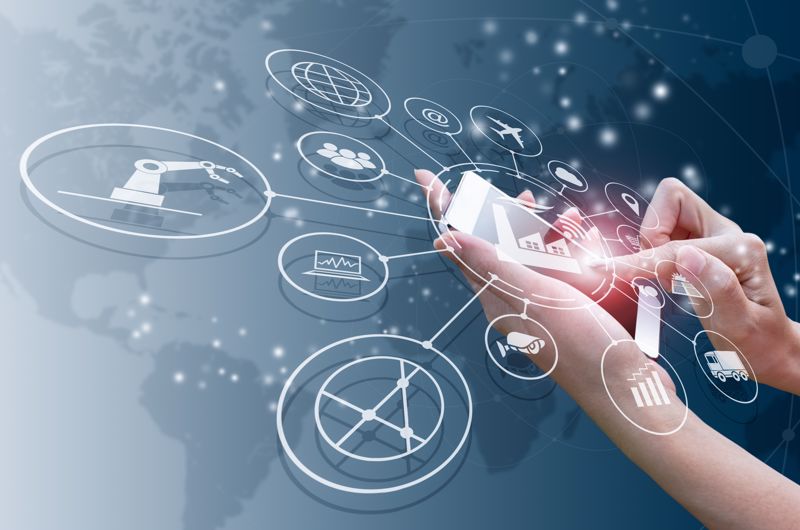
5G, IIoT and Your Company's Digital Transformation
By Max BurkhalterJanuary 5, 2021
5G is fast becoming the standard for wireless communications as manufacturers, logistic companies and other industry verticals seek to fortify their rapidly expanding Industrial Internet of Things and then utilize the environments. 5G's ultra low latency, high-level connectivity and frankly enormous concurrent data capacity allow companies to become more demand responsive and resource efficient.
In manufacturing, more IIoT devices are entering service every day, from robots reconfiguring factory floors to sensors that manage fleet maintenance for uninterrupted delivery flows. For all of these environments, wireless systems provide necessary flexibility, and 5G improves on the already burgeoning face of Industry 4.0. According to IBM, 5G is set to become the foundation platform for new applications in manufacturing, transportation and health care. IIoT adoption powered by 5G connectivity can be the driver of your digital transformation.
"Ubiquitous connectivity" is becoming a catchphrase that denotes just how powerful and dependable 5G is. When sensing and monitoring nodes are enabled using 5G, and advanced analytics are performed in real time, the result is improved factory operation at every level, from predictive maintenance to material waste reduction.
5G, IIoT and the public cloud
5G delivers even more highly enhanced bandwidth and reduced latency for certain devices. Using solutions defined from the 3rd Generation Partnership Project (3GPP) gives you the opportunity to scale critical IoT applications with a 10+ year battery life for better positioning and real-time use cases, but implementation can be a challenge.
The public cloud is capable of accommodating growing workloads, and can also be leveraged to effectively manage and protect the vast amounts of data that continually arrive from IIoT devices. Cloud migration prior to IIoT adoption can allow your expansion to be powered by 5G immediately.

Another benefit is the capability to create digital twins which analyze streaming data in real time. One "twin" sits at base station while the other resides with the device, allowing raw data to be swiftly processed. The rapid analyzing process allows quick comparison to other devices around the globe, and helps provide in-depth analysis, cumulative learning and predictive suggestions.
Since each digital twin performs data analysis in place, then only streams real-time insights in real time to the capacity management application, raw data gets discarded at the point of origin (the base station) instead of eating up capacity. This efficient handling of data reduces overall volume and permits computation to be done at memory speeds, compared to a store-then-analyze approach which delays results and can take up to 90% more space.
Misconceptions surrounding IIoT adoption
According to McKinsey, there are three primary misconceptions about IIoT implementation which must be dispelled for effective integration and management of your 5G-powered IIoT network.
First, many people think they must wait for standardization to make their move. Standardization isn't required for you to adopt 5G and IIoT now. Standardization simply isn't key to success for IIoT implementation, which is a good thing since such homogenization is likely decades away.
With new devices and options hitting the market daily, and a strong commitment to retrofitting and ensuring backwards compatibility, there's no excuse not to move forward with integration development. Your industry already operates on a massive conglomeration of tech, some months old, some decades old, and this is normal.
Second, it's often assumed that while IIoT adoption would indeed be a great step forward, it would also be a lot of work. It's taken as a given that adoption means disruption. In reality, IIoT adoption can simply drive developmental progress, accelerating an already planned course of action and helping the transformation become smoother and more effective.
Operationalizing IIoT means taking small steps, connecting devices, upgrading infrastructure and improving predictive analytics for ROI. The returns will encourage the next steps, and this positive cycle will continue.
Third, it's feared that 5G and IIT will be prohibitively expensive. The fact is that the costs associated with these new technologies are already falling quickly, making them accessible even to SMBs seeking to upgrade their connectivity.
Managing expectations
Many CIOs assume implementing 5G will be a plug-and-play affair. In the real world, 5G and IIoT adoption is more like a series of tiny advancements with a cumulative effect as opposed to an overnight transformation. Starting with 5G can help you future-proof your organization, and adding IIoT components over time can deliver long-term results and increased ROI as the effects slowly build and become exponential.
Are you ready? Carefully consider 5G and IIoT and how adoption can improve your business. Then start taking baby steps to achieve integration and digital transformation. Perle offers industrial-grade connectivity tools that can help organizations build scalable and secure networking environments. Our robust device servers can ensure reliable serial-to-Ethernet connections and support a wide range of high-performance wireless LAN technologies. Read some of our customer stories to learn more.



